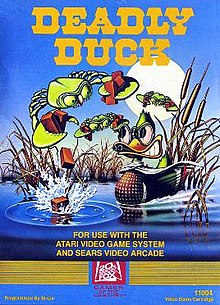| Deadly Duck | |
|---|---|
 | |
| Developer(s) | Sirius Software |
| Publisher(s) | 20th Century Fox Games |
| Designer(s) | Ed Hodapp [1] |
| Platform(s) | Atari 2600, VIC-20 |
| Release |
|
| Genre(s) | Fixed shooter |
Deadly Duck is fixed shooter game for the Atari 2600 released on January 20, 1982, [2] in North America. It was designed by Ed Hodapp for Sirius Software and published by 20th Century Fox Games. [1] [3] It was later ported, by Jeremy Jones, to the VIC-20. [4]
